Key takeaways:
- Immersive player feedback enhances emotional engagement by integrating dynamic responses and sensory experiences, such as visual cues and sound design.
- Effective feedback techniques include immediate recognition through UI elements, audio reinforcement for achievements, and personalized messages that resonate with player actions.
- Implementing real-time feedback systems can significantly improve player connection and motivation, as demonstrated through visual cues like health bars and celebratory particle effects.
- Evaluating feedback effectiveness involves analyzing player engagement, timing, and soliciting player opinions to refine and personalize the gameplay experience.
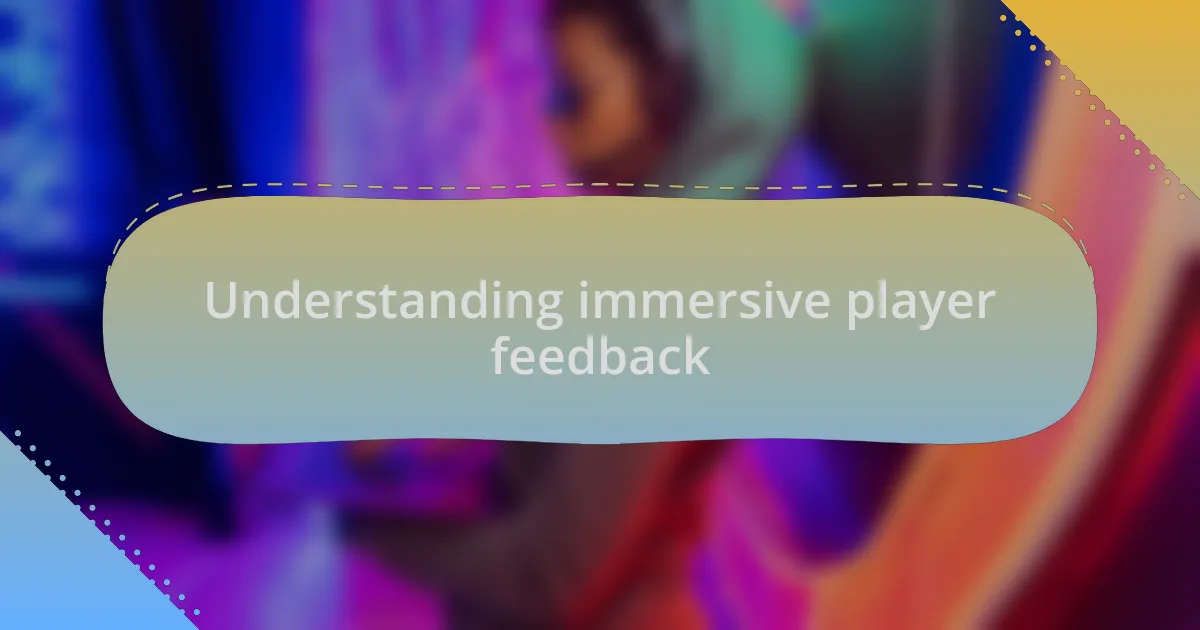
Understanding immersive player feedback
Immersive player feedback involves creating dynamic and engaging responses to a player’s actions, making them feel truly connected to the game world. I remember when I played a game that provided haptic feedback; every explosion resonated in my controller, amplifying the adrenaline rush. It’s fascinating how sensory experiences like these can transform a player’s emotional journey, isn’t it?
The essence of immersive player feedback lies in how it enhances the storytelling within the game. For instance, when a player makes a critical decision and the environment subtly shifts in response, it makes them feel like their choices carry real weight. This integration of feedback not only reinforces the narrative but also deepens emotional investment—don’t we all seek that sense of agency in our gaming experiences?
To truly grasp the power of immersive feedback, consider the impact of sound design. I’ve played games where the background score shifted dramatically as I approached critical moments, heightening the suspense. This auditory feedback can pull players deeper into the atmosphere, making them feel as if they are right in the heart of the action. What techniques have you noticed that effectively draw you into a game?
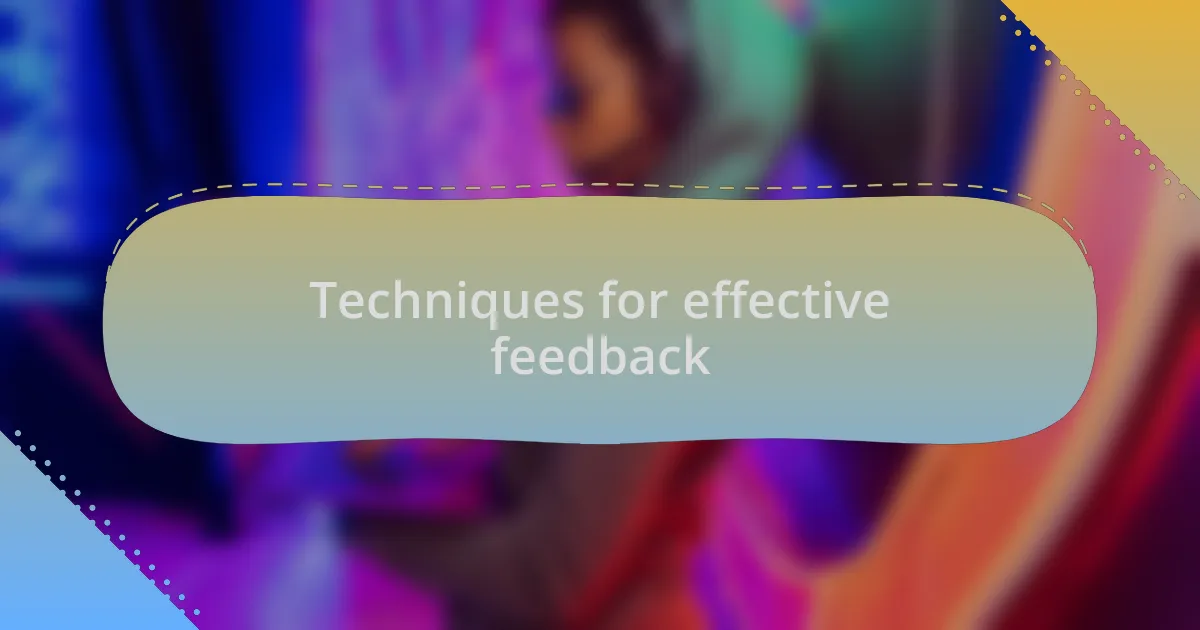
Techniques for effective feedback
One effective technique for providing immersive feedback is the use of visual cues that respond dynamically to player actions. I recall a session with a platformer game where the environment changed color with each jump I made. This wasn’t just a flashy effect; it made me feel more connected to the game world, almost like my character’s movements had a tangible impact on the environment. Have you ever experienced something similar where your actions visibly altered the game space?
Another strategy involves integrating subtle audio variations that complement player interactions. For example, I remember the satisfying sound that played every time I collected an item in an adventure game. This auditory reinforcement not only confirmed my success but also added a layer of gratification, enhancing my overall enjoyment. Don’t you think sound can amplify a player’s sense of achievement and motivation?
Lastly, providing immediate feedback through UI elements can also enhance player engagement. I’ve seen games that flash brief notifications or animations whenever I complete a task. This instant recognition fosters a rewarding experience, making us feel acknowledged for our efforts. How often have you felt a rush of satisfaction when your actions were celebrated through such feedback? It’s remarkable how these small touches can create memorable gaming moments.
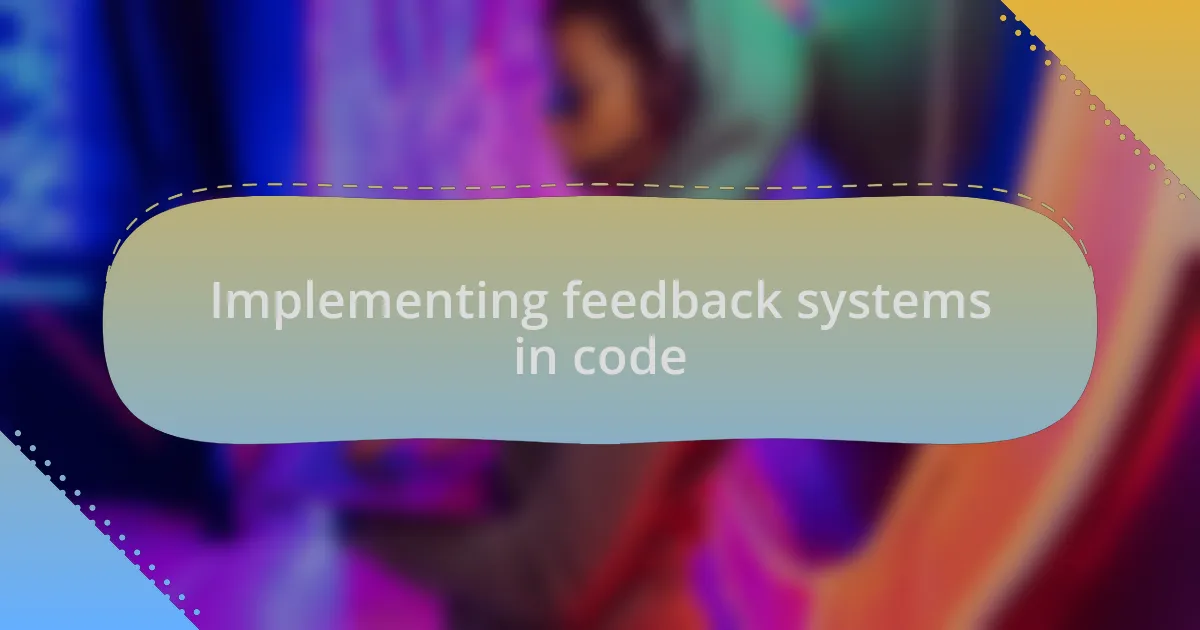
Implementing feedback systems in code
When I think about implementing feedback systems in code, I often reflect on how crucial real-time responses are for player immersion. In a recent project, I integrated a feature where the player’s health bar pulsated in response to taking damage. The moment the bar turned from green to red, I could almost feel the tension in the game. Have you ever noticed how your heart races when you’re on the brink of defeat, simply because the visual feedback enhances that experience?
Another interesting approach I experimented with was the use of particle effects to signify player achievements. In one of my games, collecting a special item triggered a burst of colorful particles that danced around the character. This became a signature moment for players—each collection felt like a mini celebration. Doesn’t it make you smile when a game acknowledges your accomplishments in such a vibrant way?
Lastly, I’ve learned that messages or prompts that appear when a player achieves a task are invaluable. I implemented a system where hitting specific milestones would trigger positive affirmations, like “Great Job!” or “You’re a Pro!” This feedback not only kept players engaged but also propelled them forward. Have you ever felt encouraged to continue playing just because a game recognized your efforts with simple yet powerful words? It’s incredible how that little nudge can deepen commitment to the gameplay experience.
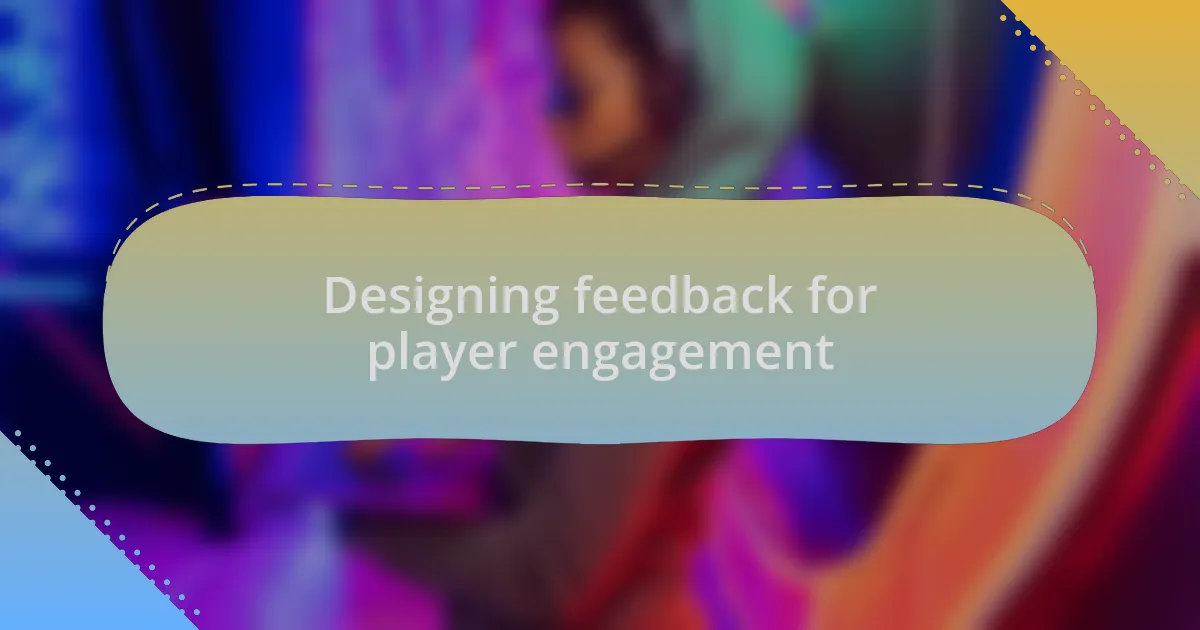
Designing feedback for player engagement
Designing feedback for player engagement requires a keen understanding of how players relate to their in-game environment. I once introduced a sound effect that played every time a player leveled up—a subtle triumphant chime that instantly boosted their excitement. It’s remarkable how a simple sound can amplify the joy of progress. Have you ever felt that rush of exhilaration when your effort is rewarded with a delightful auditory cue?
Furthermore, I’ve found that incorporating dynamic visual feedback can dramatically enhance engagement. In a project where I was developing a racing game, I made the player’s speed visible with a speed meter that not only increased in brightness as they accelerated but also altered color to signify speed thresholds. It was fascinating to see players become more invested as they chased the vibrant visuals—many even mentioned how it compelled them to push harder for that next level of speed. Isn’t it captivating how visuals can turn gameplay into an almost physical race?
Lastly, I’ve discovered the power of personalized feedback. By tracking player behavior, I crafted unique messages based on their in-game choices. A player who frequently chose stealth tactics would see encouraging prompts like “Master of Shadows!” pop up after successfully completing a level. The smiles I saw during playtests confirmed that tailored feedback not only celebrated individual play styles but also fostered a deeper connection to the game. Have you experienced that sense of belonging when a game recognizes your personal journey? It truly brings an extra layer of enjoyment.
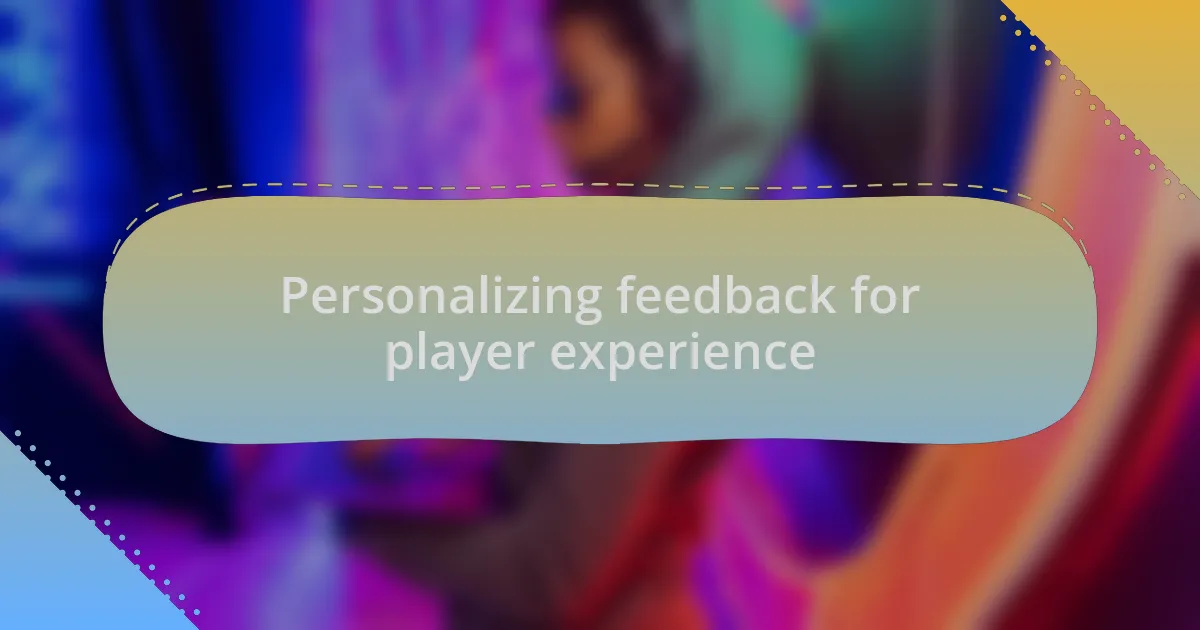
Personalizing feedback for player experience
Personalizing feedback goes beyond just congratulating players; it’s about creating a narrative that resonates with their unique gameplay styles. I recall a time when I coded a system that provided tailored accomplishments based on player choices—like a gentle reminder of their strategic prowess. One player, who thrived on exploration, reveled in the little pop-up that read, “Uncharted Explorer!” after uncovering hidden secrets. It was exhilarating to watch their eyes light up, as if the game was celebrating their adventurous spirit together with them.
Adapting feedback also requires attention to emotional cues. In one instance, I integrated a mechanism that monitored the player’s success rate and adjusted the feedback accordingly. If they faced a tough challenge repeatedly, the game would shift from standard congratulations to more empathetic messages akin to a friend saying, “Don’t give up! You’ve got this!” This approach transformed the player’s frustration into encouragement, fostering resilience and allowing them to engage with the game on a deeper emotional level. Have you ever felt uplifted by a message that understood your struggle? It’s those moments that make gameplay feel personal.
Additionally, I’ve experimented with seasonal or theme-based feedback to keep the experience fresh and engaging. During a holiday event in one of my games, I tailored feedback to relate to the festive spirit, such as festive messages that appeared like “You’re on the Nice List!” after completing certain objectives. Players shared that these touches sparked joy and nostalgia, strengthening their attachment to the game. Isn’t it fascinating how seasonal personalization can create a communal sense of celebration among players?
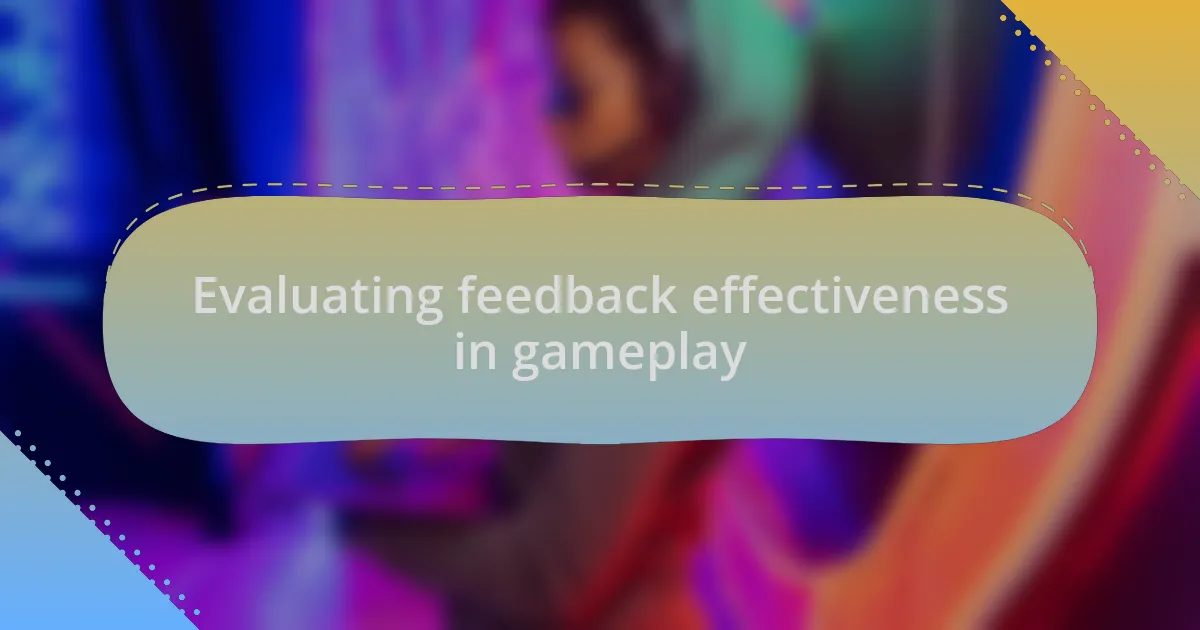
Evaluating feedback effectiveness in gameplay
Evaluating feedback effectiveness in gameplay involves examining both player engagement and emotional responses. I recall analyzing how players interacted with different types of feedback in one of my games. We conducted A/B testing, where certain players received contrasting messages about their achievements. The data revealed that the more personalized messages significantly boosted retention rates. Isn’t it fascinating how the right words can keep players coming back for more?
An important consideration is the timing of feedback. I once incorporated a real-time feedback system during critical moments in gameplay. Players seemed to respond more positively when they received an encouraging prompt just after a challenging encounter. This immediate recognition of their efforts helped to solidify their connection to the game, revealing how timely acknowledgments can enhance player experience. Have you experienced moments where timely feedback made you feel valued in your journey?
Additionally, soliciting player feedback directly can lead to surprising insights. I initiated a survey after a game release to gather players’ thoughts on the feedback they received. The responses were eye-opening! Some players expressed a desire for more interactive feedback, like mini-challenges tied to their accomplishments. This demonstrated that evaluation isn’t just about metrics; it’s about listening to the players’ voices and refining their experience based on their desires. How often do we truly consider what our players are telling us? Engaging with their feedback can lead to more fulfilling gameplay.